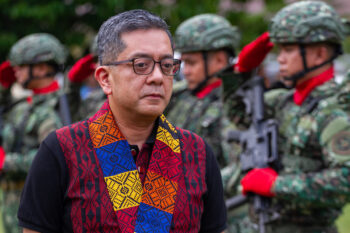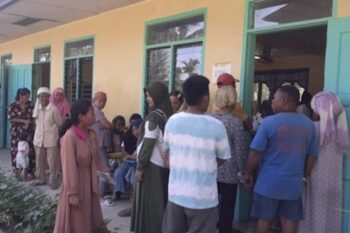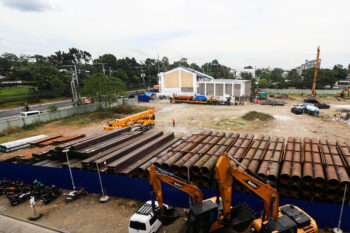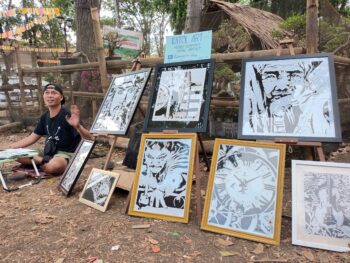(Address of Fr. Joel Tabora, SJ, President of the Ateneo de Davao University, before the 17th City Council of Davao on Feburary 16, 2016)
DAVAO CITY (MindaNews/16 February) — I am not a Davaeño by birth. I am a born Manileño. I am in Davao by virtue of my mission to Ateneo de Davao. In the more than five years I have lived here happily, I have come to love Davao – its kind and welcoming people, its multicultural vibrancy, its dearly won peace and order, its happy mix between the urban and the rural, the creative and the traditional, the new and the old, its confidence and self-consciousness as the leading city of Mindanao and the gateway to a bright tomorrow for the nation.
I feel very honored at the opportunity to speak with you, and I thank Councilor Mabel Acosta for inviting me. About my concern for Davao, it is only you I can address. You are my representatives on the City Council of Davao. In the last two elections, I voted for you.
My father was in the foreign service. As a child I spent much of my childhood in San Francisco. I spent many of the happiest hours of my childhood playing in huge green spaces of San Francisco’s Golden Gate park. When I returned to Manila in the early 60s, Manila still had many huge green spaces. That was still at a time when travelling on a four-lane Highway 54 (now, EDSA ) would get you from UP to Makati in a matter of 20 minutes tops, and high-grassed green spaces would abound on both sides of the highway, often with carabao still wallowing in the mud. Makati still had expansive green spaces, as did Pasig, Mandaluyong, Makati, Quezon City and Novaliches.
We used to live in the Kawilihan Compound of the late Sec. Jorge Vargas of Mandaluyong which was blessed with generous green spaces: I remember playing beneath mango, kaimito and guava trees, amidst blossoming sampaguita and gumamela, and the scent of dama de noche in the evening. In multiple ponds filled with water lilies, I would enjoy feeding the tilapia or chasing the dragon flies. From the viewpoint of a child, I did not realize the privilege I had of accessing the Secretary’s tennis courts, which was also a basketball court, and playing there with the friends of my youth.
From within this protected paradise, I used to look from one of the windows of our house onto the squalor of the neighboring urban poor settlement. I was shocked at their small stingy spaces, the heat of their homes in the summer, their lack of running water, the naked children playing in muddy lanes. They had no access to tennis courts. They had no access to guava and mango and kaimito trees. I could not understand. We were different. Yet we were also the same. That lack of understanding, I think, eventually led me to join the Society of Jesus.
As a Jesuit I have wrestled long with this problem. It was the reason why I spent many of my best years as a young priest living in San Pedro Resettlement Area in Laguna and later among the urban poor of Commonwealth, Q.C. I could not accept that poor people, on whom cities depended to function, did not have access to legitimate housing. Around 1990, we were assisting a small community, Sitio Kumunoy, to access the new national Community Mortgage Program in order for them to acquire the land they had been living on for years in order to do onsite relocation.
Suddenly, we got the shocking news. On behest of the influential landowner and subdivision developer, the Quezon City Mayor had suddenly sent in his demolition crews and demolished all of the people’s homes. I remember the tears, the wailing in despair, the rage in the trembling face of a young man clenching the handles of his tired bicycle. I brought my anger to Cardinal Sin and to the Bishops Businessmen’s Club. The incident was not to happen again, we demanded. The urban poor mobilized, first locally, then nationwide. They brought their anger to Congress. The result was the Urban Development and Housing Act of 1992 (RA7279).
Part of that legislation were provisions to stop unjust and inhumane demolitions – as was Sitio Kumunoy, and countless others, that would pit the poor of the demolition teams against the poor of squatters’ settlements, and bring the violence of the State onto the most vulnerable of our peoples, onto children and babies, in order to protect, even advance, the private property rights of the wealthy. It was not that private property was not to be respected, and that no demolitions could take place. But if they were to be done, they were to be done humanely, not without consultation, not without preparation, not without relocation. The urban poor are human beings with human rights, and one of the human rights with the right to food and the right to clothing is the right to shelter.
Shortly after I came to Davao in 2011 there was an extreme weather condition which suddenly flooded the Matina Pangi area terribly. ADDU mobilized to help the city respond to the thousands of victims of the horrible flash flood. Even before this relief work was over, the famous boxing incident occurred between Mayor Inday Sara and a sheriff over a demolition issue. Mayor Sara may have been excessive in displaying her boxing skills to the world. But in the context of her exhausting efforts to give succor and shelter to the victims of an extreme weather incident, why should she not wish to protect the homes of the poor from inhumane demolition? Protecting her poor, she was in fact right. According to RA 7279, the demolition was illegal. Even a court-ordered demolition should have been conducted in accordance with law and so in full coordination with local government. At that time, Mayor Inday Sara was the representative of local government. She had only been asking for two hours’ reprieve.
Why am I bringing all this up to you when we are gathered here to talk about green spaces? I do so because even beyond the details of the sad controversy which brings us together this morning, the issue of green spaces is fundamentally an issue of social justice. My position on the details of this controversy is expressed in the manifestation that I have signed and submitted to your honors this morning for your appreciation. Beyond that, however, the issue of green spaces is about social justice, just as the issue of housing for all, and protection of the human rights of all, is about social justice.
Protecting the quality of human life through green spaces, protecting the access of city dwellers to places where they can enjoy the talisay, the narra, the palms, the bamboo, the orchids, where birds and reptiles and waters are alive, protecting the cooling breezes despite the heat that concentrated populations bring in urban settings, protecting the health of our aquifers through green spaces that can regenerate them, protecting health and fresh drinking water for all, protecting the city against flooding, is an issue of social justice.
The challenge of translating social justice into policy is entrusted especially to you, the esteemed councilors of Davao for whom I voted. In an age of global environmental awareness heightened not only by the political community as in the Climate Change Forum of Paris but also by the religious community as through Pope Francis’ globally-hailed issuance of Laudato Si!, it is the challenge of protecting the environment and the common good from the interests of the ignorant, the short sighted or the greedy.
In fact the Davao City Council has done admirable work in setting an example of enlightened sensitivity for the environment and the common good for the entire country despite the objections of some. In the name of the environment and of the common good, it has prohibited cigarette smoking in public spaces, dangerous and pollutive fireworks on Christmas and New Year’s, it has prohibited toxic aerial l spraying, it has prohibited environmentally destructive mining. In a admirable act of legislative wisdom, it has enacted the Comprehensive Land Use Plan (CLUP).
Just as in compliance with RA 7279 the CLUP set aside land not only for the use of the propertied but also for the socialized housing needs of the poor (cf. Sec. 3.3.3), so the CLUP sets aside green spaces not only for the enjoyment of the wealthy but for the common good of all. It is as if the CLUP anticipated the words of Pope Francis in Laudato Si:
…we are conscious of the disproportionate and unruly growth of many cities, which have become unhealthy to live in, not only because of pollution caused by toxic emissions but also as a result of urban chaos, poor transportation, and visual pollution and noise. Many cities are huge, inefficient structures, excessively wasteful of energy and water. Neighborhoods, even those recently built, are congested, chaotic and lacking in green space. We are not meant to be inundated by cement, asphalt, glass and metal, and deprived of physical contact with nature (LS 44).
The CLUP mandated green spaces are in addition to the “open spaces” that do not need to be green. They are green spaces needed by all, which the Council does well to leave partially to the planning and creativity of private developers and private clients in private spaces, so it can focus attention and resources on the development of public green spaces for all. Shrine Hills, for example, which is geologically unsuitable for subdivision development, should be developed as green space for all. I do not understand why we are tarrying on this. We should keep in mind the ideal ratio of 9 square meters of green space per resident, and target this, to cure the sorry half-square meter per resident we have today.
Let me end by sharing that in tackling the problem of the urban poor it became clear that a principal cause of the problem was the lack of affordable housing stock. RA 7279 responded with the provision that 15 percent of a developer’s investment should be for socialized housing. That provision has brought affordable housing to many working urban poor. But when it was introduced, the subdivision developers complained that it was confiscatory. Just like they are now claiming the 10% additional green space requirement is confiscatory. But the green spaces provision is for the common good. Repealing it would be confiscatory of the improved quality of life that benefits all in Davao, the right of all to sustained fresh air to breathe, fresh water to drink, cool winds, refreshing breezes, flowers and trees, and to the general well being. It would also mean that the CLUP is unreliable as a legislated plan, alterable at the whim of the privately interested, and so as an expression of the long-term will of the people for rational urban development towards common weal inutile.
This would spell developmental chaos for Davao. It would be tragic for a Davao that has so much promise at being a world-class city – in which quality investors will certainly invest because of the wisdom and reliability of Davao’s policies, and because of the integrity and steadfastness of its policymakers. Through its creative green spaces, let Davao go the way of San Francisco, Chicago and New York, Munich, Paris and London, Seoul, Singapore and Kyoto. All the world’s great cities are going green! Let there be generous public green spaces in Davao for family picnicking under the shade of native trees which attract swallows and kingfishers, with lakes and streams alive with fish, with butterflies in the daytime and fireflies at night. Let us move forward together in the healthy implementation of the CLUP and not regress into the grime and gloom of cemetrified (cemetery-like, cement-petrified) Manila.
In this context, if Ateneo de Davao can help in further conversations, land-use planning, urban development and design, in the name of its faculty and students, and especially of its energetic engineers and talented architects, allow me to pledge our support.
Why? For the love of Davao, that’s all. For the love of its treasures in nature and the love of its people.







